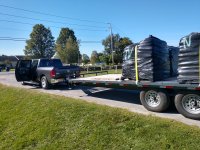RalphVa
Super Member
- Joined
- Dec 19, 2003
- Messages
- 7,902
- Location
- Charlottesville, VA, USA
- Tractor
- JD 2025R, previously Gravely 5650 & JD 4010 & JD 1025R
Wondering about your various experience/knowledge about the diesel state of the art. Just sat (actually laid) down to read a Mother Earth mag and saw a Mahindra ad. Says their diesels do not require a DPF. Yet Mahindra dropped their plans to bring over their diesel P/U, probably because of the high cost of doing lots of mileage to show emissions didn't go to pot.
I know Yanmars aren't the best: still shudder and shake on cold startup and require high idle speeds, supposedly for emissions. Yanmar technology seems to reside back in the 80s because our 1983 Benz more or less started the same in the cold and required almost identical glow plug timing. It would idle slower but didn't have to meet modern emission standards. Smoked a fair bit on heavy pull.
Isuzu starts and runs and sounds virtually like a gasoline engine except for that few second wait for the glow plugs built into its auto start. Don't know about its idle speed because it (as a generator driver) always runs at "fast idle", as JD calls those speeds. No smoke.
The VW TDI started, ran and performed like a fairly powerful (torquey) gasoline engine. It's DPF required about 5% fuel debit to start it off with a tad more fuel. Smelled afterwards, too, if you happened to stop during one or immediately right after. Absolutely no smoke, only that DPF burn stink.
Anyone else have some experience with others?
Ralph
I know Yanmars aren't the best: still shudder and shake on cold startup and require high idle speeds, supposedly for emissions. Yanmar technology seems to reside back in the 80s because our 1983 Benz more or less started the same in the cold and required almost identical glow plug timing. It would idle slower but didn't have to meet modern emission standards. Smoked a fair bit on heavy pull.
Isuzu starts and runs and sounds virtually like a gasoline engine except for that few second wait for the glow plugs built into its auto start. Don't know about its idle speed because it (as a generator driver) always runs at "fast idle", as JD calls those speeds. No smoke.
The VW TDI started, ran and performed like a fairly powerful (torquey) gasoline engine. It's DPF required about 5% fuel debit to start it off with a tad more fuel. Smelled afterwards, too, if you happened to stop during one or immediately right after. Absolutely no smoke, only that DPF burn stink.
Anyone else have some experience with others?
Ralph
